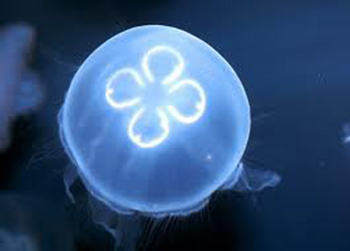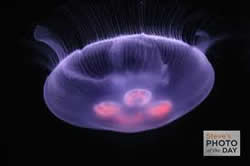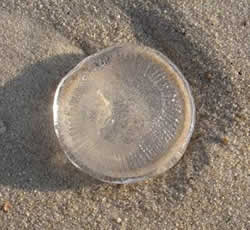Moon Jelly
Aurelia aurita

Kingdom: Animalia
Phylum: Cnidaria
Class: Scyphozoa
Order: Semaeostomeae
Family: Ulmaridae
Common names for Aurelia aurita are moon jelly fish, Saucer jelly fish and common jelly fish. It belongs to the group of very similar species in the genus Aurelia and it’s difficult to distinguish by seeing without testing their genetic material.
Distribution
These are mainly seen in Atlantic Ocean, Indian Ocean and Pacific Ocean.
Habitat
Moon jelly fish are generally seen close to shore, in harbor’s and estuaries. They live in brackish waters with as salt content of 0.6% which is very low. Temperatures that favor their survival is 9 °C to 19 °C.
Anatomy and appearance
 The moon jellyfish is transparent with a slightly bluish or pinkish color with four bright gonads shaped like horseshoes under the stomach. They can grow up to 40cms.Feeding and swimming is directed by a nerve which is present inside the jellyfish, the bottom of the medusa is fitted with tentacles which are used for catching prey. Digestive system, circulatory system and respiratory system are absent in moon jelly fish. They digest food with the help of gastro dermis that lines gastro vascular cavity where nutrients are absorbed from food.
The moon jellyfish is transparent with a slightly bluish or pinkish color with four bright gonads shaped like horseshoes under the stomach. They can grow up to 40cms.Feeding and swimming is directed by a nerve which is present inside the jellyfish, the bottom of the medusa is fitted with tentacles which are used for catching prey. Digestive system, circulatory system and respiratory system are absent in moon jelly fish. They digest food with the help of gastro dermis that lines gastro vascular cavity where nutrients are absorbed from food.
Life Span
Moon jelly adults may live mostly for more than one year in aquarium while the polyp can live up to 25 years.
Prey
Moon jelly fish is Carnivorous. They feed on organisms like Crustaceans, Protozoan’s, Diatoms, Mollusks, rotifers and tunicate larvae.
Feeding
 Moon jelly fish feeds on its prey by stinging them with nematocysts found on their long tentacles. Foods are collected on the surface of the animal which becomes entangled in the mucus. These are moved nearer to margins by actions of flagella. They are collected on lappets and are again moved by flagella into the eight separated canals which branch off and run into stomach.
Moon jelly fish feeds on its prey by stinging them with nematocysts found on their long tentacles. Foods are collected on the surface of the animal which becomes entangled in the mucus. These are moved nearer to margins by actions of flagella. They are collected on lappets and are again moved by flagella into the eight separated canals which branch off and run into stomach.
Predators
Birds, Fish and Sea turtles are common predators of Moon jelly fish. In some places humans also like to eat moon jellyfish, mainly in South-East Asia.
Behavior
Moon jelly fish swim by pulsations of the bell-shaped upper part. They swim horizontally, keeping the bell closer to the surface at all times. This enables tentacles to be spread over a large area, so that they can capture food better.
Life Cycle
Sexual maturity in Moon jelly commonly occurs in the spring and summer. Sea jelly eggs are fertilized when the female ingests strands of floating sperm released by a male. Fertilized eggs are released by female; they develop into a larval form known as a planula. This larval form floats in water till it could find a hard surface and attaches it to it and changes in to a polyp. Under favorable conditions, the polyp divides and breaks swim away. These are known as ephyra, the small sea jellies. As they grow larger, they mature to form adult sea jellies.
Blooms and grouping
Group of jellies are called smack. These jellyfish congregate in to larger groups known as blooms which consist of more than a thousand. Formation of blooms is a complex process and depends on oxygen content temperature ocean currents and nutrients.
Conservation
They play an important role in pelagic organic matter transformations. As they feed on copepods and fish larvae they may affect plankton community. These are survivors and they thrive in dirty, polluted and low oxygen water.
Facts
- Moon jelly fish are not fish these belong to phylum cnidarians, whereas fishes belong to phylum chordate.
- Moon jelly fishes are made up of 95% water.
- In 1991, more than 2000 moon jellies were sent to space in the space shuttle Columbia for a research on weightlessness on jellies development.
References
Please note that the following references may have either been removed or relocated by the webpage owners since the time this student report was created.
Dawson, M.N. 2003. Macro-morphological variation among cryptic species of the moon jellyfish, "Aurelia" (Cnidaria: Scyphozoa). Marine Biology 143: 369-379.
“Aurelia aurita.” Web 29 May 2012.< http://ihatetheocean.blogspot.com/2011_02_01_archive.html>
“Moon jelly fish life cycle.” Web 29 May 2012. < http://wn.com/The_Moon_Jelly>
“Jelly fish.” Web 30 May 2012.< http://cavinginn.wordpress.com/tag/jellyfish/>
“Moon jelly fish.” Web 31 May 2012 < http://forums.steves-digicams.com/photo-day-contest/180824-december-1-2010-moon-jellyfish.html>
“Moon Jelly Fish” Web.29 may 2012. < http://www.aquaticcommunity.com/jellyfish/moon.php>
“Moon jelly Fishes Aurelia aurita.” Web 29 May 2012.< http://marinebio.org/species.asp?id=231>
Rodriguez, R. 1999. "Aurelia aurita" (On-line), Animal Diversity Web. Accessed May 31, 2012 at http://animaldiversity.ummz.umich.edu/site/accounts/information/Aurelia_aurita.html
“The moon jelly fish” Long Beach Island. Web 31 May 2012. < http://www.longbeachislandjournal.com/animals/moon-jellyfish>